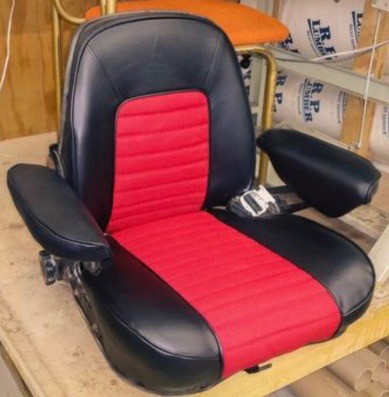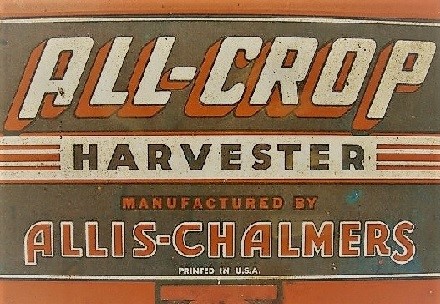| Author |
 Topic Search Topic Search  Topic Options Topic Options
|
AC7060IL 
Orange Level


Joined: 19 Aug 2012
Location: central IL
Points: 3603
|
 Post Options Post Options
 Thanks(0) Thanks(0)
 Quote Quote  Reply Reply
 Topic: Gleaner R series in wheat(small grains) Topic: Gleaner R series in wheat(small grains)
Posted: 06 May 2022 at 11:46am |
|
I know older conventional cylinder gleaner capabilities. But looking into possibly updating towards the R50/R52 Gleaner models. To those who have harvesting experience primarily in small grains(winter wheat, barley, rye, etc), how do these R models perform(threshing ability, clean grain sample,header size) in dry(13-14%)grain & wetter grain (16-20%)?? Wheat yields in the 70-90bu/acre. Any key factors to consider?
Thanks.
Edited by AC7060IL - 06 May 2022 at 11:48am
|
 |
|
Sponsored Links
|
|
 |
DrAllis 
Orange Level Access

Joined: 12 Sep 2009
Points: 22307
|
 Post Options Post Options
 Thanks(0) Thanks(0)
 Quote Quote  Reply Reply
 Posted: 06 May 2022 at 11:58am Posted: 06 May 2022 at 11:58am |
|
I'm no small grains guy, other than a very few oats. There's never been an issue with anything (that I know of) other than how chewed up the straw can be if you intend on baling it.
|
 |
CrestonM 
Orange Level


Joined: 08 Sep 2014
Location: Oklahoma
Points: 8459
|
 Post Options Post Options
 Thanks(0) Thanks(0)
 Quote Quote  Reply Reply
 Posted: 06 May 2022 at 12:58pm Posted: 06 May 2022 at 12:58pm |
|
I’ve heard a lot of people say the rotaries do great in all crops, but particularly wheat. There’s a few in the area around me still running R series and they all like them. We had S97s when I went on harvest, and they were wheat eating machines. Most of the grain was pretty dry but did occasionally hit a few higher moisture spots. They did great either way.
|
 |
Daehler 
Orange Level Access

Joined: 23 Nov 2010
Location: Lexington MO
Points: 1167
|
 Post Options Post Options
 Thanks(0) Thanks(0)
 Quote Quote  Reply Reply
 Posted: 06 May 2022 at 6:15pm Posted: 06 May 2022 at 6:15pm |
|
I was running 3.5 to 4 mph with a 24 ft head in 90 to 100 bu wheat a couple years ago. Had .5 bu loss behind machine. I guess that's considered capacity. A 50 or 52 would need the narrow space rotor bars for sure to keep cylinder loss down or thats what I've been told. Rotary machine would just out eat a conventional any day. If you have a impeller instead of chopper then straw does come out fairly long but it does chew it up some.
|
|
8070FWA,7080 BlackBelly, 7045,2 200s,D19,D17,G, WD,45,UC,7 AC mowers and lots more!
"IT TAKES 3 JD's TO OUT DO AN ALLIS, 2 TO MATCH IT IN THE FIELD AND 1 FOR PARTS!"
|
 |
shameless dude 
Orange Level


Joined: 10 Apr 2017
Location: east NE
Points: 13607
|
 Post Options Post Options
 Thanks(0) Thanks(0)
 Quote Quote  Reply Reply
 Posted: 06 May 2022 at 9:06pm Posted: 06 May 2022 at 9:06pm |
|
last small grain i combined was oats and used an N5, it did an excellent job in the field, and it did chop up the straw good.
|
 |
ajl 
Bronze Level

Joined: 31 Dec 2009
Location: Alberta
Points: 115
|
 Post Options Post Options
 Thanks(0) Thanks(0)
 Quote Quote  Reply Reply
 Posted: 07 May 2022 at 11:02pm Posted: 07 May 2022 at 11:02pm |
|
Have run an R75 in hard red spring wheat and barley and they do well in both. Like all combines, when the grain is tough it is easier to put it out the back. Some debate about the number of reverse bars on the rotor in wheat. Fewer reverse bars=more throughput but potentially more loss. I think two is likely optimal. Never see a 52 size machine around here just the 62/72 ones.
|
 |
AC7060IL 
Orange Level


Joined: 19 Aug 2012
Location: central IL
Points: 3603
|
 Post Options Post Options
 Thanks(0) Thanks(0)
 Quote Quote  Reply Reply
 Posted: 11 May 2022 at 11:48am Posted: 11 May 2022 at 11:48am |
|
The chewed up straw is better yet. Not wanting to bale any straw.
I’m guessing that rotor sizes (diameter/length) is the major change for both;
-Series (N, r, r0,r2,r5,..etc?
-Model sizes within a series?
I’ve also read about improvements over series per feeder housings, rotor, cage, accelerator rolls, shoe length, chopper,spreader, ...etc. (hyperized, P1,P3, etc) So any particular model or rotor/cage setup that’s better/best or one to avoid? I also read about sunnybrook, CDF, Bison, Precision Farm Parts, etc.
Edited by AC7060IL - 11 May 2022 at 11:56am
|
 |
DrAllis 
Orange Level Access

Joined: 12 Sep 2009
Points: 22307
|
 Post Options Post Options
 Thanks(0) Thanks(0)
 Quote Quote  Reply Reply
 Posted: 11 May 2022 at 7:46pm Posted: 11 May 2022 at 7:46pm |
|
Until you get into the Super "7" series (67/77) the rotors are all 25 inches in diameter and either 70 inches long (R-40-50-42-52-55) or 90 inches long (N-5-6-7/R-5-6-7/R-60-70/R-62-72/R-65-75/R-66-76). You're talking R-50-52 series, so I will address those processors. These machines have what is called the P-3 processor which has short segmented cylinder bars about 18 inches long each in each of three stations. Normally I prefer the "wide-tooth" cylinder bar over the threshing area, which would be the right and center stations. If you are seriously going to do small grains, I don't think you'll be happy with the threshing of these crops with wide spaced teeth, which were really designed for corn/soybeans. You would desire a square-tooth 1 5/8" long chaffer for corn and soybeans and 1 1/8" short finger std chaffer for small grains. The helical bars inside the cage must be in good condition and when replacing them, chrome is worth the extra money as they last twice as long. Stay away from any websites that offer all kinds of "hyperizing" of a machine you haven't even used yet !! Most of these parts are to go faster and faster and unless you aren't happy with the machines appetite as it is, stay away !! There are "reverse" flow cylinder bars on these combines and to start, you'll need two on the discharge end. To have zero reverse bars may cause to much rotor loss, so start with two and go from there. This is an actual adjustment to the processor to dial in what your desired results will be. R-50/52 is a nice small 6-row combine in corn that will do you 1,000 BPH when set right. Soybeans 6 or 8 rows depending on your terrain. The accelerator rolls must be in good condition and will wear the most on the right side under the concave area. I have replaced many one time on the right side only and then the next time both left and right sides.
Edited by DrAllis - 11 May 2022 at 7:52pm
|
 |









 Topic Options
Topic Options

 Post Options
Post Options Thanks(0)
Thanks(0)




